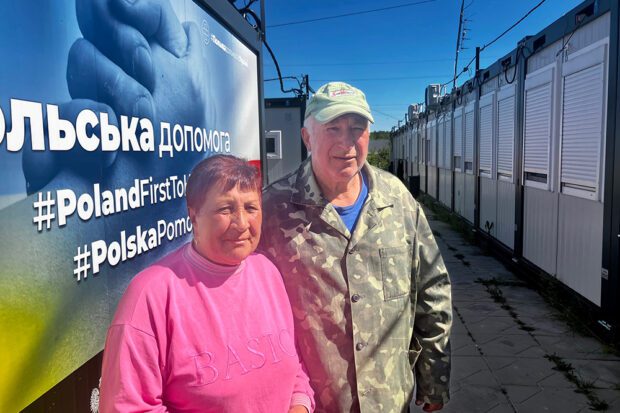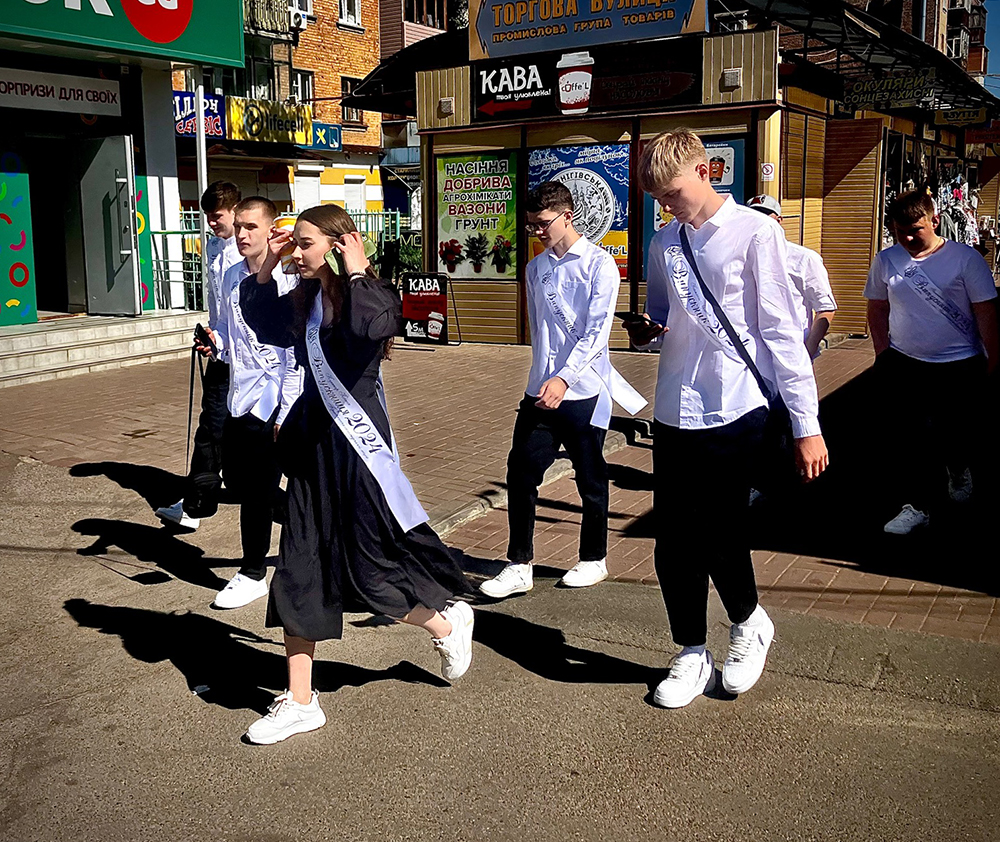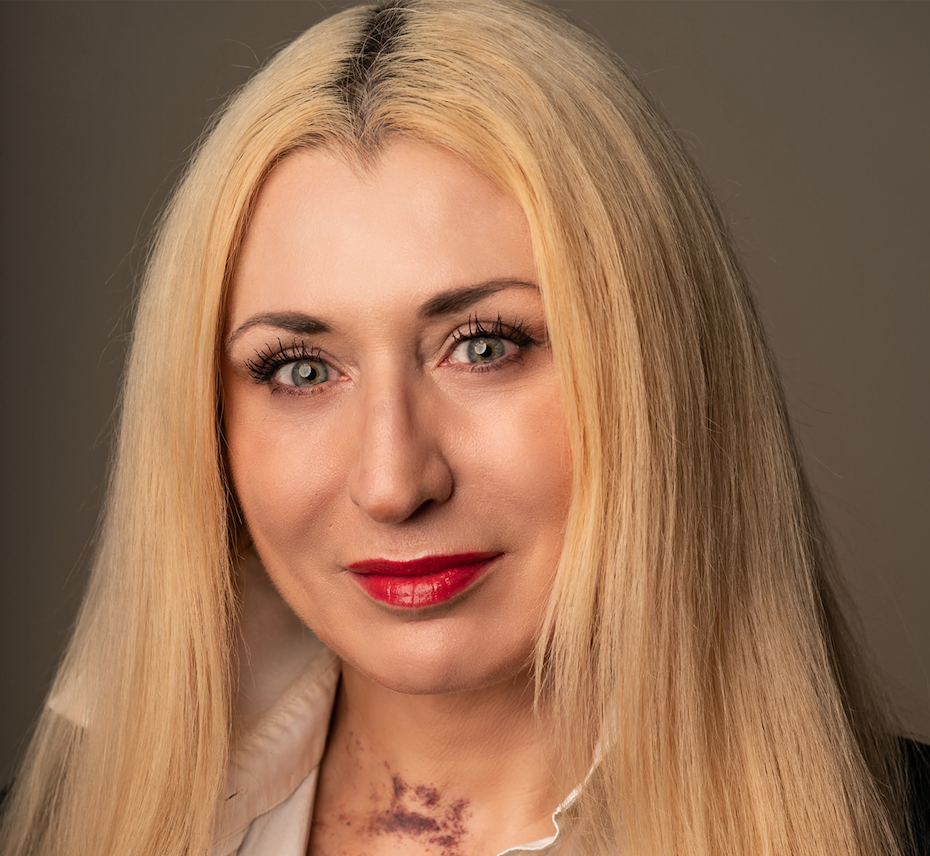
Volodymyr is the mayor of Novoselivka, a village in northern Ukraine, located only 50 miles south of the border where Russian troops are conglomerating again. There are talks of a new offensive. A jolly man in his late 50s, he seems to know everyone in his village.
Visiting a village mobile home project, he jokes with many refugees, or, rather internally displaced people (IDP), and they joke back at him. Several housing projects were built as temporary shelters by Polish charity organizations after the liberation of the Chernihiv region from the Russian occupation.
According to Volodymyr, more than 80% of houses in Novoselivka were destroyed during the 2022 Russian offensive at the start of the full-scale invasion. Two years later, people still live in train-like structures.
Nadia, a retiree from Novoselivka, her husband Misha, and their 40-year-old daughter sleep on bunk beds in a compartment-size room, with their belongings in plastic containers. Nadia, who suffered a stroke recently, is one of three sisters: each one had lost her home to the Russian bombardments in the spring of 2022.
During my first reporting trip from the Chernihiv region in September 2022, I interviewed their mother. The 83-year-old Lusiya, sitting on a bench in front of her ruined house, told me about Russians bombing their family houses. In her bright-yellow hustka, a head kerchief, she looked heartbroken. Lusiya died in the winter of 2023.
The remaining family is waiting for the construction of their mobile home to be finished. They are grateful to volunteers from the U.S. fund Love to Ukraine, which is funding the construction. Other states and organizations, including the Netherlands, Poland, the Red Cross and the United Nations, are also providing help to Novoselivka.
The second mobile housing center accommodates families both from Novoselivka and new IDPs from the areas right on the Russian border.
Lena, a tired-looking blonde in her 40s, has just arrived at the center. She fled her home village Semenyvka in mid-May 2024 after an aerial bomb had hit close to her house. Russian troops target the village with artillery shelling, mortar, and tank fire every day.
Lena’s friends and acquaintances were killed as shelters were scarce. She and her three children, aged 9 to 19, settled in a small, stuffy room. The kids attend an online school. Sasha, 9, said he was afraid of bombs back home.
This housing center is located near the destroyed skiing base and athletic training center. Svitlana, an athletic trainer with 33 years of experience, lives in a mobile home and continues to train children and teenagers, many also living in temporary housing.
In the winter of 2022, Svitlana’s home and the skiing center were destroyed by Russian aerial bombs. The skiing school might have lost the building but continues to work: A group of 10 children and teenagers roller-skate around the ruins to the sounds of a never-ending air raid.
Yuliia, the bright-eyed and energetic volunteer in her mid-20s, wears a t-shirt that reads “I was born free.” Freedom is the top value in the Chernihiv region, just as all around Ukraine. So is the community spirit.

Yuliia, her child and her husband live in temporary housing and work hard to restore her house and the village—in the face of a new danger. Yuliia points at the crumbling remains of houses, burned vans and cars, and two flags flapping in the wind: Ukrainian and European.
“We paid with our lives, [our] homes, our future to stop the Russian hordes here in 2022,” she says. “If they come back and we have no weapons, we won’t be able to stop them again.”
In the nearby regional center, Chernihiv, Olha Makukha, the editor of the city newspaper Vist, echoes this sentiment, adding a frightful idea. “There were many times in history when Russians forced Ukrainians to fight for them. It is happening now in the Donbas, in the Luhansk and Donetsk regions. The invaders might make our soldiers fight against Europe under the fear of being shot.”
Traveling around Ukraine and interviewing civilians and military in different paths of life show that a negligent percentage of Ukrainians would consider joining the invaders voluntarily. Yet, knowing the Russian strategy of weaponizing fear, the concept of mobilizing Ukrainians on the side of the occupying power must not be dismissed out of hand.
Chechnya is a good example: After two brutal wars, the Chechen Republic was forced into the Russian Federation and many Chechens are now fighting in the Russian army in Ukraine.
In the summer of 2024, the narrative of “brotherly Slavic nations of Russia and Ukraine fighting the evil West together” was generated by the Kremlin and amplified on social media by the Russian state-paid trolls with the goal of putting pressure on Europe and forcing Ukraine to the negotiating table.
Chernihiv holds both symbolic and strategic significance for the Kremlin.
Chernihiv was one of the principal cities of Kyivan Rus’, a medieval East Slavic state that flourished from the 9th to the 13th century. Modern Russia has “canceled” Kyivan Rus’ and adopted the term “Ancient Rus” in textbooks and academic discourse. This revisionist approach reflects Vladimir Putin’s geopolitical ambitions, justifying Russia’s historical claims and emphasizing a shared past under a broader “Ancient Rus” umbrella. The goals are to assert control over Ukrainian territories and erase Ukrainian identity.
Strategically, Chernihiv’s resistance played a critical role in stopping the Russian military’s plan to capture the Ukrainian capital, Kyiv, in three days. When the Russian invasion of Ukraine began on Feb. 24, 2022, Chernihiv was a key target in the “Northern Ukraine offensive.” Despite being besieged, the city did not fall, disrupting the Russian objective.
On April 4, 2022, Russian military forces withdrew from the Chernihiv region. The siege left Chernihiv about 70% destroyed, and attacks on the city have continued throughout the ongoing war.
In one of the most brutal strikes, on Aug. 19, 2023, Russian troops attacked the Chernihiv Drama Theatre with a missile. Seven civilians were killed, including a six-year-old girl, and 144 civilians were injured, including 15 children and 15 police officers. The explosion damaged 10 administrative buildings and 66 residential buildings.
The theater is currently under repair, but the philharmonic hall is open. A jazz cabaret show was sold out: A packed audience arrived all dressed up in the national colors of yellow and blue for a fundraiser for the army. In a moving scene, an amputee dancer, who lost his leg in combat, played the part of an amputee soldier. About 30 minutes into the show, the siren for another ballistic threat forced the public out of the theater.

The air was filled with poplar fuzz, white and fluffy, tiny moths and mosquitoes and the sounds of a bird feeding frenzy, but the spacious squares and wide streets of Chernihiv looked peaceful. Cafés and restaurants were bustling, families strolled toward a beautifully kept central park and music was ringing in the air.
The calm was deceptive as Chernihiv, located only 50 miles from the border with the Russian Federation, is under continuous attacks just as the rest of Ukraine’s northern and northeastern regions.
Recently, on the morning of April 17, Russian military forces launched a missile strike on Chernihiv, destroying one and damaging four high-rise residential buildings, a hospital, dozens of cars and a higher-education institution and killing 18 civilians and injuring seven.
In response, Ukrainian President Volodymyr Zelenskyy appealed to Western countries for air defense equipment, stating that the attack occurred because the Ukrainian Army was running out of defense missiles.
With ongoing threats and the potential for renewed Russian offensives, ensuring Ukraine’s defensive capabilities is crucial not only for Ukraine’s freedom but also for preventing the worst Kremlin narratives from becoming reality.

